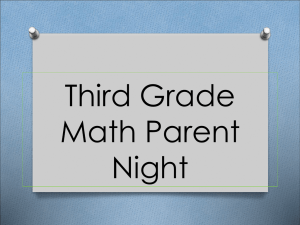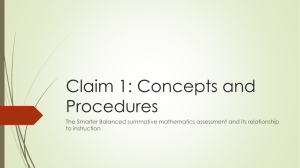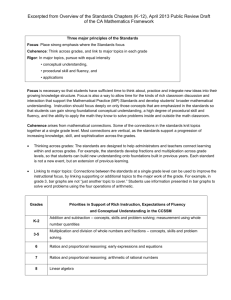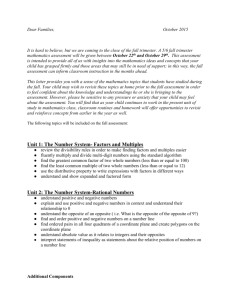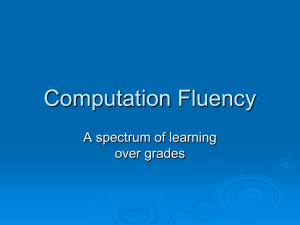Focus 1 Components of Mathematics Module 2 Nov 12, 2014
advertisement
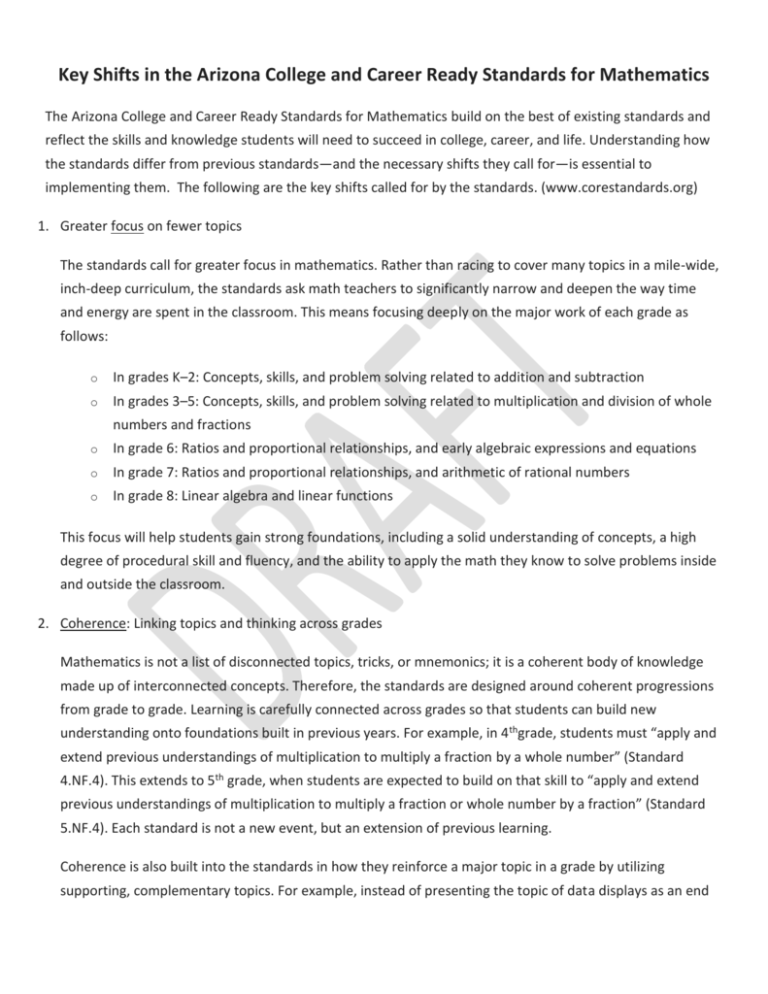
Key Shifts in the Arizona College and Career Ready Standards for Mathematics The Arizona College and Career Ready Standards for Mathematics build on the best of existing standards and reflect the skills and knowledge students will need to succeed in college, career, and life. Understanding how the standards differ from previous standards—and the necessary shifts they call for—is essential to implementing them. The following are the key shifts called for by the standards. (www.corestandards.org) 1. Greater focus on fewer topics The standards call for greater focus in mathematics. Rather than racing to cover many topics in a mile-wide, inch-deep curriculum, the standards ask math teachers to significantly narrow and deepen the way time and energy are spent in the classroom. This means focusing deeply on the major work of each grade as follows: o In grades K–2: Concepts, skills, and problem solving related to addition and subtraction o In grades 3–5: Concepts, skills, and problem solving related to multiplication and division of whole numbers and fractions o In grade 6: Ratios and proportional relationships, and early algebraic expressions and equations o In grade 7: Ratios and proportional relationships, and arithmetic of rational numbers o In grade 8: Linear algebra and linear functions This focus will help students gain strong foundations, including a solid understanding of concepts, a high degree of procedural skill and fluency, and the ability to apply the math they know to solve problems inside and outside the classroom. 2. Coherence: Linking topics and thinking across grades Mathematics is not a list of disconnected topics, tricks, or mnemonics; it is a coherent body of knowledge made up of interconnected concepts. Therefore, the standards are designed around coherent progressions from grade to grade. Learning is carefully connected across grades so that students can build new understanding onto foundations built in previous years. For example, in 4 thgrade, students must “apply and extend previous understandings of multiplication to multiply a fraction by a whole number” (Standard 4.NF.4). This extends to 5th grade, when students are expected to build on that skill to “apply and extend previous understandings of multiplication to multiply a fraction or whole number by a fraction” (Standard 5.NF.4). Each standard is not a new event, but an extension of previous learning. Coherence is also built into the standards in how they reinforce a major topic in a grade by utilizing supporting, complementary topics. For example, instead of presenting the topic of data displays as an end in itself, the topic is used to support grade-level word problems in which students apply mathematical skills to solve problems. 3. Rigor: Pursue conceptual understanding, procedural skills and fluency, and application with equal intensity Rigor refers to deep, authentic command of mathematical concepts, not making math harder or introducing topics at earlier grades. To help students meet the standards, educators will need to pursue, with equal intensity, three aspects of rigor in the major work of each grade: conceptual understanding, procedural skills and fluency, and application. Conceptual understanding: The standards call for conceptual understanding of key concepts, such as place value and ratios. Students must be able to access concepts from a number of perspectives in order to see math as more than a set of mnemonics or discrete procedures. Procedural skills and fluency: The standards call for speed and accuracy in calculation. Students must practice core functions, such as single-digit multiplication, in order to have access to more complex concepts and procedures. Fluency must be addressed in the classroom or through supporting materials, as some students might require more practice than others. Application: The standards call for students to use math in situations that require mathematical knowledge. Correctly applying mathematical knowledge depends on students having a solid conceptual understanding and procedural fluency. Components of Mathematics Instruction Fluency Application •Word problems • Constructed Response (short or extended) •Fluency Practice •Mental Math •Spiral Review Concept Development •Activities •Journals •Math talk/discourse Mathematical Understanding Fluency (mental & strategically) Skill in carrying out procedures flexibly, accurately, efficiently, and appropriately. Fluency is needed to support conceptual understanding (Adding It Up, 2001). Fluency is not meant to come at the expense of understanding but is an outcome of a progression of learning and sufficient thoughtful practice. It is important to provide the conceptual building blocks that develop understanding in tandem with skill along the way to fluency; the roots of this conceptual understanding often extend one or more grades earlier in the standards than the grade when fluency is finally expected. (PARCC MCF, v3.0, p. 12) Wherever the word fluently appears in a content standard, the word means quickly and accurately. It means more or less the same as when someone is said to be fluent in a foreign language. To be fluent is to flow: Fluent isn’t halting, stumbling, or reversing oneself. A key aspect of fluency in this sense is that it is not something that happens all at once in a single grade but requires attention to student understanding along the way. It is important to ensure that sufficient practice and extra support are provided at each grade to allow all students to meet the standards that call explicitly for fluency. (PARCC MCF, v3.0, p. 9) Mental Math Calculations that are done in a student's head without the guidance of pencil and paper, calculators or other aids. Mental math is often used as a way to calculate and estimate quickly, using math facts that a student has committed to memory, such as multiplication, division or doubles facts. Number talks were developed for classroom teachers to engage students in “mental math” through grappling with interesting mathematics problems. Educators can use number talks regularly as introductions to the day’s mathematical practice, as “warm ups” for other lessons, or as stand-alone extended engagements with mathematical concepts (www.insidemathematics.org) Spiral Review Incorporate an on-going cumulative review into instruction every day. Almost no one masters something new after one or two lessons and one or two homework assignments. That is why one of the most effective strategies for fostering mastery and retention of critical skills is daily, cumulative review at the beginning of every lesson which is recommended to include: • A fact of the day • A term of the day • A picture of the day • An estimate of the day • A skill of the day • A measurement of the day • A word problem of the day 5 minutes x 180 days = 900 minutes 900 minutes ÷ 60 = 15 hours 15 hours – ½ of a college course 15 hours – one/hour week of tutoring for a semester That’s a lot of time! (Accessible Mathematics, Leinwand, 2009) Conceptual understanding (via activities, journals, math talk) Comprehension of mathematical concepts, operations, and relations. Students with conceptual understanding know more than isolated facts and methods. They understand why a mathematical idea is important, and the kinds of contexts in which it is useful. They have organized their knowledge into a coherent whole, which enables them to learn new ideas by connecting those ideas to what they already know. (Adding It Up, p. 118, 2001) The standards call for conceptual understanding of key concepts such as place value and ratios. Teachers support students’ ability to access concepts from a number of perspectives so that students are able to see math as more than a set of mnemonics or discrete procedures (Key Instructional Shifts of the CCSSS-M, Achievethecore.org) Word problems The ability to formulate, represent, & solve mathematical problems. School math often presents students with fairly straightforward problems to solve, which stands in contrast to problems they encounter in the “real world”, which includes the added difficulty of defining what the problem actually is. Therefore, students need experiences formulating problems, as well as solving them. They should be able to apply a variety of solution strategies, as well as discern which strategy is the most efficient/helpful, depending on the context/set-up of the problem. Becoming strategically competent involves avoiding becoming a “number grabber” and instead focusing on the relationships among quantities. (Adding It Up, 2001) Extended constructed responses Capacity for logical thought, reflection, explanation, and justification. (Adding It Up, 2001) Problems worth doing: Multi-step problems, conceptual questions, applications, and substantial procedures will be common (PARCConline.org). To offer students opportunities to gain experience & fluency communicating mathematically, developing & analyzing arguments & evidence, and come to deeper mathematical understandings (Smarter Together, Featherstone et al, 2011). NOTE: ***There might be overlap in these elements*** For example, if I teach 4th grade, and in a month, I conduct a number talk regarding the following set of expressions I would actually be accomplishing the goal of several of the components. 41 x 1, 41 x 10, 41 x 100, 41 x 1000, 41 ÷10 Fluency of powers of ten & mental math (noticing and discussing patterns) would be evident. A discussion about what is happening & why (powers of ten)would also incorporate conceptual understanding, as opposed to if I teach my kids to “count the zeroes & move the number” . AND, this would be a spiral review, as this concept was already taught at the beginning of the school year.

